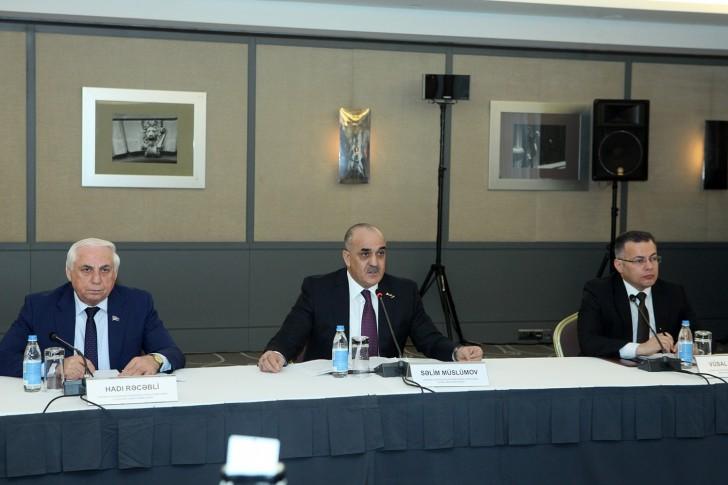Demand in labor market to exceed the supply by several times next 8 years

By Aygul Salmanova
A conference on “Labor Market: Reforms, Challenges and Perspectives” was held jointly by the Ministry of Labor and Social Protection of Population and the Center for Economic Reforms and Communications on December 20.
The event was attended by Minister for Labor and Social Protection of Population Salim Muslumov, chairman of the Committee on Social Policy of the Parliament Hadi Rajabli, the executive director of the Center for Analysis of Economic Reforms and Communication of Azerbaijan Vusal Gasimli, President of AmCham Nuran Kerimov and other officials.
In his opening speech, Muslumov highlighted the important macroeconomic achievements achieved in the country and spoke about the development trends in the labor market.
“Reforms aimed at the development of the labor market in the conditions of sustainable economic development in Azerbaijan have created conditions for the country's increasing rating in this area. The Fact that Azerbaijan, which ranks 35th among 137 countries in the 2017-2018 Global Competitiveness Report of the World Economic Forum, once again confirms that,” he said.
Referring to the processes in the labor market in the past period, the minister said that the challenge of employment in this context, as well as the ability of the able-bodied population to meet labor market needs is urgent.
Muslumov noted that the labor market is formed under the influence of factors determining the demand and supply of labor: “The demographic situation, the gender-age structure of the population, the ability to work, the employment of the unemployed population, the labor migration, the level of education, etc. are factors contributing to the proposal of the labor force. Factors affecting the determination of labor force requirements include economic growth dynamics, fiscal situation, monetary policy, investment policy measures, etc,” he said.
The minister said that one of the key issues determining the quality of labor resources is related to the level of education and specialization. He also said that the modern trends in the country’s economy put forward new challenges for vocational training and highlight the challenge of addressing competitive demand in the labor market.
“According to the electronic information system for labor contract registration, 37.5 percent of hired workers (36.5 percent of male employees and 38.6 percent of female workers) have higher education. Of total employed, 37.5 percent have secondary education, 22.3 percent have secondary vocational education, 2.7 percent have primary vocational education.”
Touching upon the factors determining the supply of labor force, the minister stressed that Azerbaijan is a stable country from demographic perspective: “In 2006-2016 average annual population growth rate in Azerbaijan was about 1.3 percent. This is one of the highest indicators among European countries. During this period, the population of the country increased by 14.7 percent and reached 9.8 million by January 1, 2017. As of November 1, 2017, the country's population reached 9,883,300 people. Women constitute 50.1 percent of the population.”
Muslumov noted that the median age of the Azerbaijani population is 32.3 years.
“Citizens under the age of 14 accounted for 22.6 percent of the country’s population, citizens aged 14-29 years old accounted for 25 percent of the country’s population, and citizens aged 30-64 years old accounted for 46.1 percent of the country’s population,” Muslumov added. “The share of citizens aged 65 years and older was 6.3 percent.”
High share of youth in the population’s structure led to an increase in the share of the able-bodied population, he said.
Muslumov added that this figure increased from 59.5 percent in 2000 to 68.4 percent as of early 2017, and this increases the need to create new jobs.
The minister noted that in 2005-2016, Azerbaijan’s economically active population grew 17.2 percent.
“At the same time, higher growth rates were observed in the spheres of construction, accommodation of tourists, catering, information and communication, as well as financial and insurance activity,” he said.
Muslumov said that the high share of women and youth among the unemployed is one of the main problems in the labor market. He noted that the economic development of Azerbaijan is observed by the year-round increase in the foreign labor force directed to our country.
The minister said that in the next eight years, the number of Azerbaijani citizens annually entering the labor market will exceed the number of workplaces by almost 2.5 times.
“The total number of Azerbaijani citizens aged 18 years old will be 1.127 million people in 2017-2025,” he noted. “That is, 125,200 people will be entering the labor market every year, which is almost 2.5 times higher than the number of jobs created in one year. Considering labor migration and other factors, we can reduce this number to 100,000 people per year. However, this is also a very high indicator challenging us. We must strengthen measures to employ the youth.”
An average annual real increase of over 3 percent in GDP and more than 450,000 new jobs are to be created by 2025, he added.
Muslumov mentioned that while making a systematic analysis, it can be concluded that mainly the version of the American model combined with the Swedish model has been applied in Azerbaijan.
Rajabli while making remarks at the event said that new challenges regarding the changes in the labor market require continuous improvement of the policy in this area and implementation of the vocational training, noting that this conference is important in terms of discussing this issue.
He highlighted the importance of the self-employment program and noted that through the realization of the employment potential of low-income families, this program enables the low-income families to create small family businesses.
--
Follow us on Twitter @AzerNewsAz
